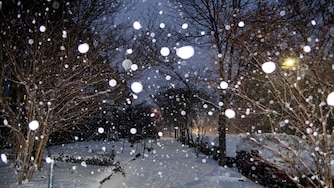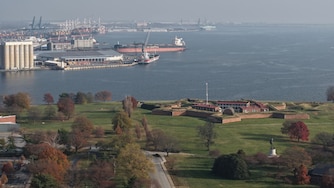Chris Lerch, who drives to his teaching job in Anne Arundel County from Northeast Baltimore every day, has made peace with the fact that downtown traffic is just going to suck.
“It’s like a video game, there’s [underground] fires, you never know when there’s going to be an accident. … It always keeps life interesting,” said Lerch, who shifted his daily commute to city thoroughfares after the collapse of the Francis Scott Key Bridge pushed more traffic into the downtown tunnels.
Downtown drivers like Lerch have dealt with a lot lately, with some reporting worse-than-usual backups along key corridors like President Street’s connection with Interstate 83, Light and Pratt streets and beyond.
Gridlock got you down? First, take a deep breath, find your zen and remember, you’re not just stuck in traffic, you ARE the traffic. But there are some other possible reasons aside from yourself for why it seems to have gotten worse:
1. Retimed traffic signals
Baltimore’s Department of Transportation is working with a handful of consultants on a multiyear project to retime most traffic lights around the city, a proposed solution to one of Baltimore drivers’ biggest gripes with downtown.
The department has kept the project on the down-low since a $4.5 million contract with Mead & Hunt was approved in 2023, but documents obtained by The Baltimore Banner through public records requests show the operation is humming along.
The downtown business district was one of the first areas where they started planning, though the boundaries for this project are unclear. Sections of East and South Baltimore already have gotten new timing to mitigate increased congestion in the wake of the collapse of the Francis Scott Key Bridge, according to progress reports.
The process has a lot of moving parts. Engineers used video equipment to get traffic counts at any given intersection; the transportation department entered a new contract with a tech company that can attach a device to the aged traffic signals that allow them to be controlled and adjusted remotely — 140 signals downtown will get one. The timing patterns go through modeling, field tests and tweaks once implemented.
In September, the transportation department told The Banner that it hoped to green light the new central downtown timing patterns by mid-October. At some intersections, pedestrians have noticed longer time intervals to cross the street before cars get a green light. On President Street — and elsewhere — drivers have noticed shorter light cycles.
The National Association of City Transportation Officials recommends 60-to-90-second light cycles for urban areas, though many cities are increasingly implementing shorter ones to minimize speeding but keep traffic flowing more consistently.
Shorter light cycles may not be Baltimore driver-proof, though.
“Blocking the box” — the selfish practice of blocking an intersection instead of waiting behind the line when there’s no room on the other side — is the ultimate nemesis of traffic flow. And signal retiming success may depend on retiming entire geographic areas at once, not just specific corridors. It’s unclear just how piecemeal the implementation of new timing patterns has been.
2. Roadwork and changing traffic patterns
Light Street. Guilford Avenue. Charles Street. Orange cones closing off travel lanes for maintenance work have been all over the place.
Crews can’t resurface or pave roads once the weather drops to consistent, near-freezing temperatures. So Baltimore could be seeing the tail end of a rush to get some road projects done before pavers go into hibernation until the spring, creating a patchwork of choke points.
Traffic patterns are still settling into a new normal since the Key Bridge collapse, too. Lerch has noticed that Fridays are better than other days, presumably because of an increase in teleworking, but some like him don’t have that option.
“Teachers and health care workers and first responders, we all have to be on the job in person … and there’s a lot of us,” he said.
3. Underground fires
Baltimore’s underground scene is so hot right now.
A string of fires below Charm City’s streets in recent months had reverberations above ground. They knocked out some traffic signals in the immediate aftermath, and transportation officials mobilized to send officers out to certain intersections to help direct traffic on multiple occasions, documents show.
Mayor Brandon Scott also organized a “underground services working group” with companies like BGE and Verizon to “propose solutions to ongoing infrastructure challenges,” according to a letter sent out to working group invites.
Traffic controllers have been out on the street in yellow vests waving their hands even when the lights are working. They have been posted at intersections throughout downtown, including outside the office of The Baltimore Banner on East Pratt Street, on and off the past couple of months.
So what can you do?
- Adjust your schedule: Start your work day virtually instead of driving during rush hour if your boss is cool with it. Try an alternate route, even if it means leaving the house 10 minutes earlier.
- Try the bus, other transit options, or carpool: Looking around at cars on the road at rush hour can be disturbing — so many only have one person in them (not the most efficient use of space, folks). The more people take transit, the fewer cars are on the road, plain and simple. Baltimore’s transit options aren’t exactly known for consistent speed and reliability, but service is most frequent at rush hours. Drive to a bus or train stop, then use transit for the final leg. Carpool with a co-worker or someone you know who works nearby. Even if you both get stuck in traffic, at least you’re doing your part!
- Hop on a bike: Does the story of the tortoise and the hare have another lesson to teach us about taking two wheels instead of four? Probably a stretch. But being able to go fast doesn’t matter when bad congestion prevents it. And the flexibility of being able to take bike lanes, hop off the bike and walk on the sidewalk or quickly pivot to side streets could make it an easier commute than you may realize. And what about e-bikes?
- Lay on the horn and scream into the void: I do not recommend this option, but hey, it is an option. You do you.





Comments
Welcome to The Banner's subscriber-only commenting community. Please review our community guidelines.